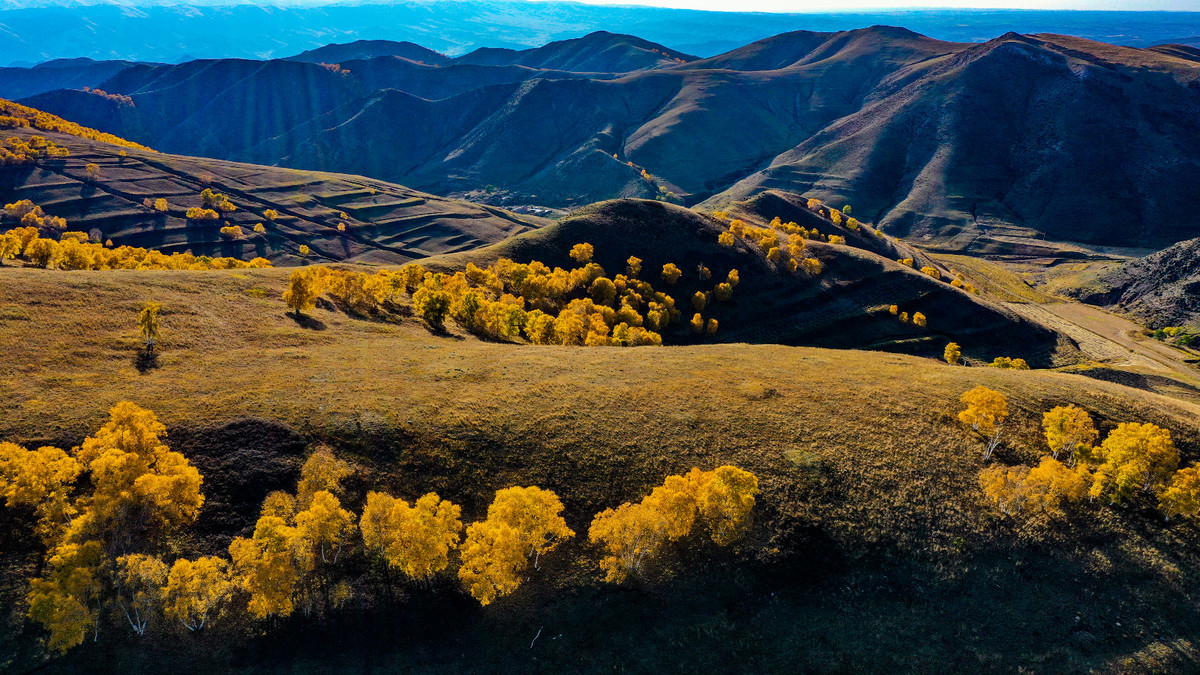The Yin Mountains, China

Scenes from Susanna White's television adaption of Charlotte Brontë's novel Jane Eyre, emphasize the story's theme of travel through their consistent efforts at characterizing Rochester's character. The show maintains a tension between Rochester's well-traveled background and Jane's inexperienced-but-curious attitude, and in doing so draws the watchers' eye to the characters' discussions of geographical locations — their history, importance, and most importantly: allure. As Rochester utilizes his travel stories to entice Jane, they also function to further escalate the comparisons between Rochester and Jane and grant watchers context to the world as it compares to Britain.
After Jane returns to Thornfield from visiting Gateshead, Rochester approaches her in the library as she's placing her childhood book into Thornfield's collection. He offers to tell Jane of his travels in "the Blue Mountains in Mongolia," in exchange for her story of her trip back to Gateshead. While the contrast between the two stories once again positions Rochester and Jane as unequal in their experiences, Rochester nonetheless regards Jane's story as one of equal value. Calling her experience "travels" just as he calls his own and referring to her experiences as "black and gloomy forests" — or something mysterious to be explored.
Aside from Jane's "travels," Rochester's note of his time in Mongolia is representative of the West's imperialism and by extension, Rochester's own position in society. For Britain, the early nineteen-hundreds would have been a time of exploration and establishing trade in both India (the East India Trading Company) and elsewhere. China was not an uncommon place of travel, as several nations would soon establish treaty ports and concessions within the country as a means to study, trade, and preach religion — these concessions occurred between 1840-1940 and allowed foreign nations comfortable power within the country ("Treaty Ports in China 1557-1999"). There is a high possibility that the "Blue Mountains" Rochester refers to are the Yin Mountains, located in Northern China. An alternate name for the mountain range is the "Daqing Mountains" (大青山) which, due to the polysemous character "青," can translate to the great "blue," "green," or "black" mountains respectively (Nan and Hui; Tao and Wong). Though this mountain range is located in China today, Rochester refers to their location as being in Mongolia. In Jane's time the status of Inner Mongolia's ownership was unstable. At the end of the seventeenth-century, the region had been conquered by the Manchus — a distant relative of the Mongols — who controlled China during the Qing dynasty ("Imperial Conquest and Central Asian Identities"; The Editors of Encyclopædia Britannica). However, the area was still inhabited by several native Mongol tribes ("Inner Mongolian Autonomous Region").
The show makes an interesting decision to translate "qīng" to "blue," as it's more commonly referred to "green" first in online records. The audience might use this choice to inform Rochester's character, as one that leans away from the natural world (as the color green often represents). While this may seem contradictory to his constant facts and lessons on animals, informed by the semantic choice, we might consider this to be a strategy that increases his allure and status in society — meaning that his true interest is not the nature itself but the prestige it gives him. This is further supported by the fact that many of Rochester's travels to other countries were with the intent of finding women to distract him from his life with Bertha. Even within the scene, we see Rochester using his experience as a way to entice — similarly building up his reputation in Jane's eyes as well.

Works Cited
"Treaty Ports in China 1557-1999." Chinasage. https://www.chinasage.info/foreign- enclaves.htm. Accessed 20 March, 2022.
"Inner Mongolian Autonomous Region:" Infoplease. https://www.infoplease.com/encyclopedia/places/asia/china/inner-mongolia... region/history#:~:text=After%20the%20Revolution%20of%201911,Ningxia%2C%20Sui yuan%2C%20and%20Chahar. Accessed 20 March, 2022.
Nan, Hao and Hui, Yuan. "Green Mountain Revitalized." ChinaDaily, 7 July, 2014. http://usa.chinadaily.com.cn/life/2014-07/07/content_17653825.htm. Accessed 20 March 20, 2022.
Tao, Jiashu and Wong, Jock. "The Confounding Mandarin Colour Term 'Qīng': Green, Blue, Black or All of the Above and More?" Studies in Ethnopragmatics, Cultural Semantics, and Intercultural Communication, October 2019, 95-116. Doi: 10.1007/978-981-32-9979-5_6.
The Editors of Encyclopædia Britannica. "Qing Dynasty." Britannica. https://www.britannica.com/topic/Qing-dynasty. Accessed 20 March, 2022.
Images:
"In Search of Chinggis Khaan's Tomb." The Mongolist. https://themongolistdotcom.wordpress.com/2011/08/17/in-search-of-chinggis-khaans-tomb/.
Yan, Lee. Autumn Gives Hohot's Daqing Mountain new look. https://en.gmw.cn/2020- 10/20/content_34285721_6.htm.
Coordinates
Longitude: 108.802500000000
